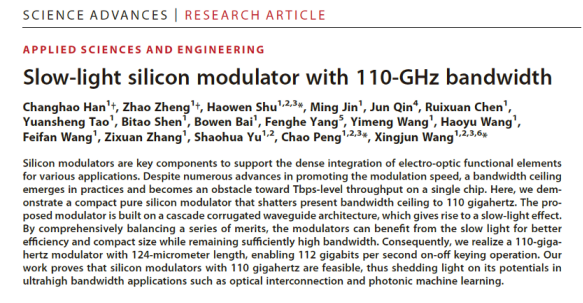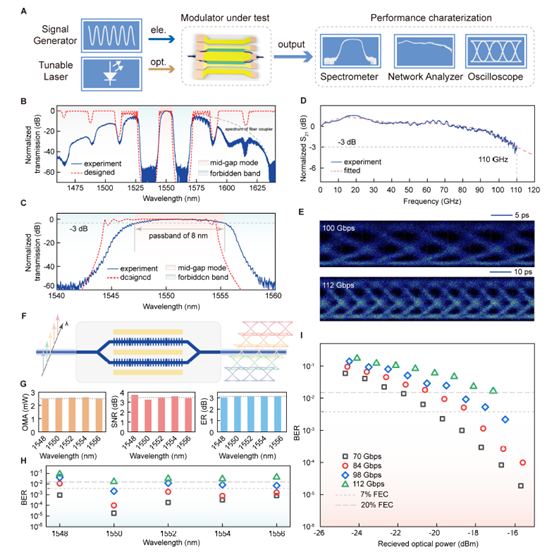
Congratulations to Professor Peng Chao, consultant of micro source photon scientists, on his team's development of a 110GHz pure silicon modulator
Time:2023-10-23Number of views:3608
Recently, a joint team of Professor Wang Xingjun, Professor Peng Chao, and Researcher Shu Haowen from the School of Electronics at Peking University has achieved a record breaking breakthrough in the field of ultra-high speed pure silicon modulators, achieving the world's first pure silicon modulator with an electro-optic bandwidth of 110GHz. This is the first time that Intel has increased the bandwidth of pure silicon modulators to over 100GHz internationally since reporting the first 1GHz silicon modulator in the journal Nature in 2004. This pure silicon modulator has advantages such as ultra-high bandwidth, ultra-small size, ultra large passband, and CMOS process compatibility, meeting the needs of future ultra-high speed application scenarios for ultra-high speed, high integration, multi wavelength communication, high thermal stability, and wafer level production. It is of great significance for the development of the next generation of data centers. On October 20th, the relevant research results were published online in the Science sub journal "Science Advances" under the title of "Low light silicon modulator with 110-GHz bandwidth".

图片来源于网络
With the large-scale application of new generation information technologies such as artificial intelligence, big data, cloud computing, and the Internet of Things, the global data volume is showing an exponential growth trend. Optoelectronic integration technology represented by silicon based optoelectronics has become an important development trend in optical communication systems. In silicon-based optoelectronic chip systems, silicon-based modulators can achieve functional conversion from electrical signals to optical signals, and have advantages such as low cost, high integration, and CMOS process compatibility. They are key active devices for on-chip information transmission and processing. However, due to the slow carrier transport rate of silicon materials themselves, the typical bandwidth of pure silicon modulators is generally 30-40GHz, making it difficult to adapt to future communication rates exceeding 100Gbaud. Therefore, it has become one of the bottlenecks for the further development of silicon based optoelectronics in the high-speed field.

基于慢光效应的硅基调制结构(图片来源于网络)
In this work, the research team addressed the issue of bandwidth limitations in traditional silicon based modulators and utilized the silicon based coupled resonant cavity optical waveguide structure to introduce slow light effects. A complete theoretical model of silicon based slow light modulators was constructed, and by adjusting structural parameters reasonably to comprehensively balance optical and electrical indicators, deep optimization of modulator performance was achieved. The research team designed and prepared an ultra-high bandwidth silicon based slow light modulator operating at a communication wavelength of around 1550 nm in a pure silicon material system based on a CMOS compatible silicon based optoelectronic standard process, achieving an ultra-high electro-optical bandwidth of 110 GHz, breaking the bandwidth limit of pure silicon modulators to date, and reducing the modulation arm size to the order of one hundred micrometers, The high-speed signal transmission of a single channel exceeding 110 Gbps is achieved in a simple OOK modulation format without the need for DSP, reducing algorithm cost and signal delay, while maintaining high uniformity of multi wavelength communication performance within a super wide optical passband of up to 8 nm. The research team has achieved a leap in bandwidth performance of silicon based modulators without introducing heterogeneous materials and complex processes, enabling low-cost wafer level mass production, showcasing the enormous value of silicon based optoelectronics in the next generation of ultra high speed applications.

超高带宽硅慢光调制器性能表征(图片来源于网络)
The co first authors of this paper are Han Changhao, a 2023 doctoral graduate from the School of Electronics at Peking University (currently a postdoctoral researcher at the University of California, Santa Barbara), and Zheng Zhao, a 2019 doctoral student. Professor Wang Xingjun, Professor Peng Chao, and Researcher Shu Haowen from the School of Electronics at Peking University are the corresponding authors of the paper. The main collaborators also include Bai Bowen, an associate researcher at the School of Electronics at Peking University, postdoctoral Chen Ruixuan, Wang Feifan, Zhang Zixuan, doctoral graduates Jin Ming, Tao Yuansheng, doctoral students Shen Bitao, Wang Yimeng, Wang Haoyu, associate professor Qin Jun at Peking University of Information Technology, and Yang Fenghe, an associate researcher at Zhang Jiangshi Laboratory. Academician Yu Shaohua from Pengcheng Laboratory participated in this work and provided important guidance. This work was completed by the State Key Laboratory of Regional Optical Fiber Communication Network and New Optical Communication System of School of Electronics, Peking University as the first unit.
Link to original paper:https://www.science.org/doi/10.1126/sciadv.adi5339
Article source: PKU Electronics Scholar